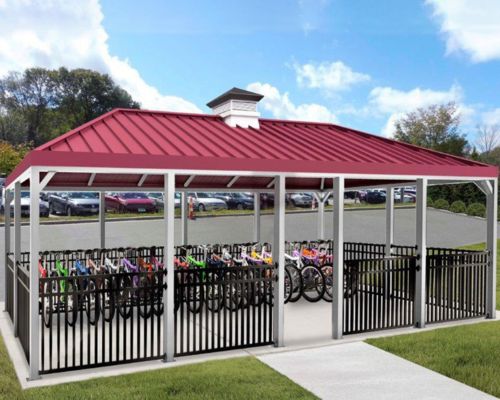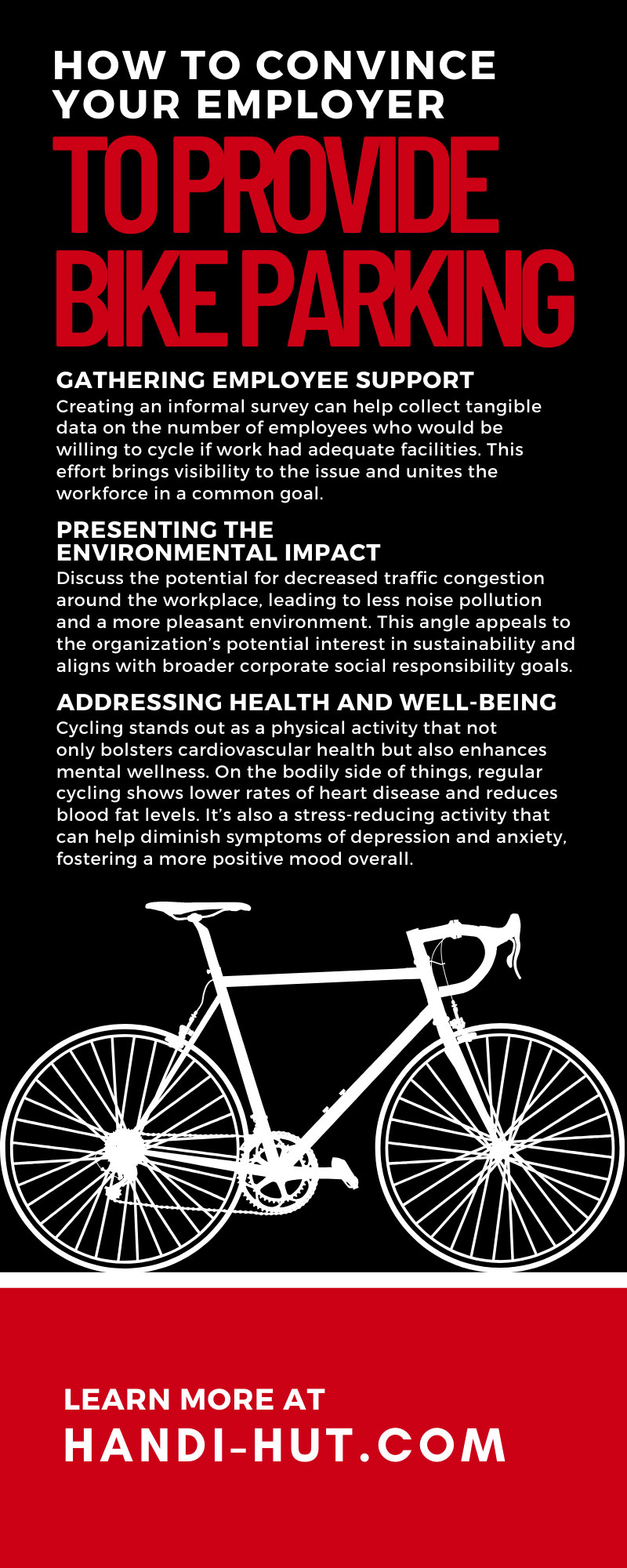
The rise in environmental consciousness and the pursuit of healthier lifestyles have increasingly led many to swap their car keys for bike helmets, making cycling to work a growing trend. This shift contributes to reducing carbon emissions and fosters a more active daily routine, which can significantly improve mental and physical health.
Despite these clear benefits, the infrastructure at many workplaces remains unsupportive of this green initiative, with insufficient or non-existent bicycle parking facilities. Secure bike parking is a critical component in supporting and encouraging this sustainable mode of transportation.
With the right approach and an emphasis on the benefits of biking to work, you can easily convince your employer to invest in bike parking to enhance the company. These strategies will persuade your employer to make a valuable addition to the workplace and make it greener.
Assessing the Current Situation
Morning exercise often results in higher levels of energy and productivity throughout the day. However, without the right facilities to ensure the safety and security of their bikes, potential cyclist employees may refuse to opt for this healthier commute.
Take the time to evaluate your workplace’s current provisions for cyclists. When assessing the current situation, it’s important to consider factors such as the convenience of location, protection from the weather, and security against theft or vandalism.
Gathering Employee Support
Gathering employee support is more than just collecting signatures; it’s about fostering a community that values health, sustainability, and the promotion of cycling as a viable mode of transportation. Start by initiating discussions with your colleagues to gauge their interest in biking to work and the challenges they face without proper bike parking.
Creating an informal survey can help collect tangible data on the number of employees who would be willing to cycle if work had adequate facilities. This effort brings visibility to the issue and unites the workforce in a common goal.
Presenting the Environmental Impact
Presenting the environmental impact of cycling to work is a powerful argument that will enhance your convincing efforts. When addressing your employer, emphasize that cycling significantly reduces one’s carbon footprint compared to driving, a crucial factor in combating climate change.
Also discuss the potential for decreased traffic congestion around the workplace, leading to less noise pollution and a more pleasant environment. This angle appeals to the organization’s potential interest in sustainability and aligns with broader corporate social responsibility goals.
Demonstrating the Economic Advantages
Demonstrating the economic advantages of providing bike parking involves highlighting the cost savings for both the employees and the organization. For employees, the transition from car to bicycle commuting can equate to substantial savings on fuel, parking fees, and vehicle maintenance.
The reduced demand for car parking spaces can lower the need for extensive parking infrastructure, which is often a significant expense in terms of construction, maintenance, and land use. Enhancing this argument with actual calculations on potential savings or testimonials from companies who have experienced these advantages can make the proposition even more persuasive.
Addressing Health and Well-being
In the area of health and well-being, cycling stands out as a physical activity that not only bolsters cardiovascular health but also enhances mental wellness. On the bodily side of things, regular cycling shows lower rates of heart disease and reduces blood fat levels. However, it’s also a stress-reducing activity that can help diminish symptoms of depression and anxiety, fostering a more positive mood overall. For employers, improved employee well-being translates into a workforce that is more productive, with employees taking fewer sick days and demonstrating greater engagement in their work.
Proposing Solutions
When proposing solutions for bike parking, it’s essential to outline specific types of bike parking facilities and their advantages. The primary options include basic bike racks, bike lockers, and bicycle shelters. Each serves a different need and accommodates various security and space considerations.
Basic Bike Racks
Bike racks are the simplest form of parking, requiring minimal space and installation effort. When placed strategically around the workplace, they can provide convenient and quick parking for employees.
Bike Lockers
Bike lockers provide individual storage units that protect against theft, vandalism, and weather elements. They are a superb option for employees who value security and are willing to use the facilities long-term.
Bicycle Shelters
Reliable bicycle shelters offer a middle ground between racks and lockers, providing overhead protection from the weather for multiple bikes while utilizing locking mechanisms similar to bike racks. Shelters promote cycling culture within the workplace, as they visibly demonstrate the organization’s commitment to sustainable and healthy modes of transportation.
When presenting these options, it’s useful to include visual aids or catalogs from manufacturers to give a clearer idea of the aesthetic and functional considerations. Consulting with a professional planner or architect can ensure that the selected bike parking solution is feasible for the available space and complies with any local zoning laws or regulations.
Discussing Implementation Plans
When trying to convince your employer to provide bike parking, it’s critical to approach the project with a structured timeline and a clear understanding of the logistical requirements. Begin by identifying potential vendors who specialize in the provision and installation of bike racks, lockers, and shelters.
Consider the most strategic locations for these facilities. Ensure their placement has adequate lighting day and night and easy access for employees. Also, discuss the financial aspect of implementing bike parking facilities, depending on the chosen solution, materials, and scale of the project.
Addressing Safety and Security Concerns
Addressing safety and security concerns is essential in encouraging employees to cycle to work. Safe and secure bike parking reassures employees that their investment in cycling, often involving high-value bicycles and accessories, has the right protection.
Discuss the importance of surveillance systems, such as CCTV cameras, which act as a deterrent to theft and vandalism. Additionally, encourage them to implement access control measures for bike parking areas, such as keycard access for bike lockers or sheltered parking zones.
Fostering a Culture of Sustainability
Fostering a culture of sustainability within an organization transcends the mere provision of bike parking; it signals a broader commitment to environmental stewardship and social responsibility. This initiative can be part of a larger sustainability strategy that includes recycling programs, energy conservation measures, and the promotion of green products and services.
Encouraging employees to adopt sustainable practices in their daily work and personal lives creates a ripple effect, leading to greater community awareness and action toward environmental protection.
By approaching your employer with a well-structured argument supported by evidence and a clear demonstration of the benefits, you can make a compelling case for the installation of bike parking. The goal is to create a win-win scenario where both employees and the company benefit from the initiative.

